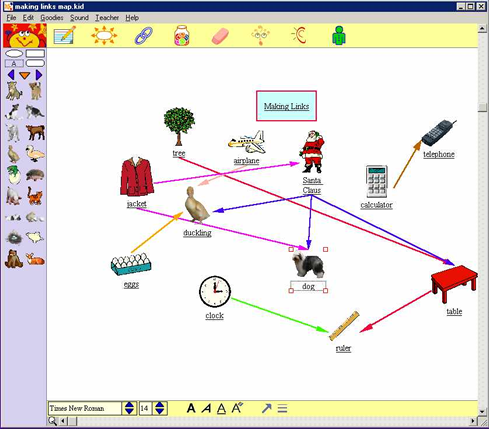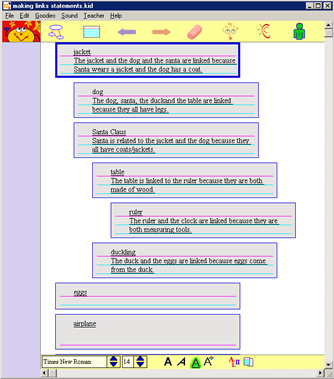
 |
Teaching Thinking and ICT |
|
|
 |
The activities were carried out in the computer suite, where the children worked in groups of 3. The children were encouraged to make connections between 12 objects on screen, and to use the mapping tools in Kidspiration to create visual links to organise their ideas.
The software enables the children to move between the visual diagrams to a writing view where the children can expand upon their ideas and give reasons for their links. Children were already familiar with the format of the software and had previously used its tools to create an explanation text to illustrate the life cycle of a duck.
To lead the children into the lesson and to encourage the children to think creatively, the teacher led a range of short thinking games such as Odd One Out (from Thinking Through Primary Teaching) and Consequences (from Top Ten Thinking Tactics). The children were reminded of the talk rules and then given thirty minutes to discuss and make the relevant links between objects on screen. Groups were able to print out their work, giving them instant access to their work to be used in a whole class debate.
To bring the work to a conclusion, the children were brought together
to share their reasons for the links they had made. They were encouraged
to challenge and counter- challenge each other, as long as they could
justify their reasons and offer alternative hypotheses. The work did
engage the children in exploratory and creative talk, and provided
and enjoyable level of challenge. Ideas were considered by all members
of the class, and reasons given to support their views.
 |
Claim:
"The calculator and the phone are linked because they've both
got buttons".
Counter- challenged:
"But what about the clock, the phone and the calculator as
they all have numbers?"
This really got the children engaged in conversation, finding reasons why their links are justified and seeing how other children have linked the objects together for different reasons. The children also came up with more analytical and creative reasoning such as "The clock and the egg- box are linked because the clock has twelve numbers on it, and the egg- box has twelve eggs in it".
Further information
Dawes, L. Mercer, N and Wegerif, R. (2000) Thinking Together: A
Programme of activities for developing thinking skills at KS2 Birmingham:
Questions Publishing (see also their web site http://www.thinkingtogether.org.uk/).
Fisher, R. (1997) Games for Thinking Oxford: Nash Pollock
Higgins, S. (2001) Thinking Through Primary Teaching Cambridge:
Chris Kington Publishing ISBN 1 899857 39 7
Lake M. and Needham, M. (1993) Top Ten Thinking Tactics Birmingham:
Questions Publishing Company.
Kidspiration (Inspiration Software, Inc. www.inspiration.com
)
|
Three kidspiration sample files used in this activity are linked here; |
|
|
Links
for PC;Making
links, Making
links map, Making
links statements Note that you may need to install the demo version of Kidspiration before these links will work... |
|
| Demo version
of Kidspiration for PC
- and for Mac |
|